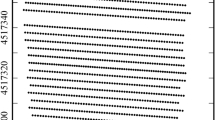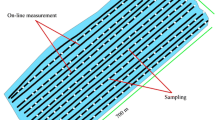Abstract
The paper describes a geostatistical approach for combining multi-source data with different support for field delineation into homogeneous soil zones. It takes into account change of support explicitly given the critical influence of spatial resolution on the statistical characteristics of estimates. Geophysical and hyperspectral data were used in combination with soil chemical properties measured in the laboratory on 50 samples collected in a field cropped with Tomato (Solanum lycopersicum, L. cv San Marzano). The approach consisted in performing Gaussian anamorphosis with support correction, multi-collocated block cokriging and factorial block cokriging to jointly analyse all data. Two regionalised factors at different spatial scales were retained to split the field into homogeneous zones for site-specific management. The results emphasize the impact of spatial scale on site-specific management.











Similar content being viewed by others
References
Aïchi, H., Fouad, Y., Walter, C., Viscarra Rossel, R. A., Lili Chabaane, Z., & Sanaa, M. (2009). Regional predictions of soil organic carbon content from spectral reflectance measurements. Biosystems Engineering, 104(3), 442–446. https://doi.org/10.1016/j.biosystemseng.2009.08.002.
Armstrong, M. (1998). Basic linear geostatistics. Berlin, Heidelberg, Germany: Springer, Berlin Heidelberg. https://doi.org/10.1007/978-3-642-58727-6.
Bremner, J. M. (1996). Nitrogen‐total. In D. L. Sparks (Ed.), Methods of Soil Analysis. Part 3. Chemical Methods (pp. 1085–1121). Madison, WI: American Society of Agronomy and Soil Science Society of America.
Burgess, T. M., & Webster, R. (1980). Optimal interpolation and isarithmic mapping of soil properties: II Block kriging. Journal of Soil Science, 31(2), 333–341. https://doi.org/10.1111/j.1365-2389.1980.tb02085.x.
Buttafuoco, G., Castrignanò, A., Cucci, G., Lacolla, G., & Lucà, F. (2017). Geostatistical modelling of within-field soil and yield variability for management zones delineation: a case study in a durum wheat field. Precision Agriculture, 18(1), 37–58. https://doi.org/10.1007/s11119-016-9462-9.
Castrignanò, A., Buttafuoco, G., Quarto, R., Parisi, D., Viscarra Rossel, R. A., Terribile, F., et al. (2018). A geostatistical sensor data fusion approach for delineating homogeneous management zones in Precision Agriculture. CATENA, 167, 293–304. https://doi.org/10.1016/j.catena.2018.05.011.
Castrignanò, A., Quarto, R., Venezia, A., & Buttafuoco, G. (2019). A comparison between mixed support kriging and block cokriging for modelling and combining spatial data with different support. Precision Agriculture, 20(2), 193–213. https://doi.org/10.1007/s11119-018-09630-w.
Castrignanò, A., Wong, M. T. F., Stelluti, M., De Benedetto, D., & Sollitto, D. (2012). Use of EMI, gamma-ray emission and GPS height as multi-sensor data for soil characterisation. Geoderma, 175–176, 78–89. https://doi.org/10.1016/j.geoderma.2012.01.013.
Castrignanò, A., Giugliarini, L., Risaliti, R., & Martinelli, N. (2000). Study of spatial relationships among some soil physico-chemical properties of a field in central Italy using multivariate geostatistics. Geoderma, 97(1–2), 39–60. https://doi.org/10.1016/S0016-7061(00)00025-2.
Castrignanò, A., Buttafuoco, G., Quarto, R., Vitti, C., Langella, G., Terribile, F., et al. (2017). A combined approach of sensor data fusion and multivariate geostatistics for delineation of homogeneous zones in an agricultural field. Sensors (Switzerland), 17(12), 2794. https://doi.org/10.3390/s17122794.
Castrignanò, A., Costantini, E. A. C., Barbetti, R., & Sollitto, D. (2009). Accounting for extensive topographic and pedologic secondary information to improve soil mapping. CATENA, 77(1), 28–38. https://doi.org/10.1016/j.catena.2008.12.004.
Cavallo, G., De Benedetto, D., Castrignanò, A., Quarto, R., Vonella, A. V., & Buttafuoco, G. (2016). Use of geophysical data for assessing 3D soil variation in a durum wheat field and their association with crop yield. Biosystems Engineering, 152, 28–40. https://doi.org/10.1016/j.biosystemseng.2016.07.002.
Chilès, J.-P., & Delfiner, P. (2012). Geostatistics: Modeling spatial uncertainty (2nd ed.). Hoboken, NJ, USA: Wiley. https://doi.org/10.1002/9781118136188.
Cobo, J. G., Dercon, G., Yekeye, T., Chapungu, L., Kadzere, C., Murwira, A., et al. (2010). Integration of mid-infrared spectroscopy and geostatistics in the assessment of soil spatial variability at landscape level. Geoderma, 158(3–4), 398–411. https://doi.org/10.1016/j.geoderma.2010.06.013.
Conforti, M., Matteucci, G., & Buttafuoco, G. (2018). Using laboratory Vis-NIR spectroscopy for monitoring some forest soil properties. Journal of Soils and Sediments, 18(3), 1009–1019. https://doi.org/10.1007/s11368-017-1766-5.
Corwin, D. (2005). Geospatial Measurement of Apparent Soil Electrical Conductivity for Characterizing Soil Spatial Variability. In J. Alvarez-Benedi & R. Munoz-Carpena (Eds.), Soil-water-solute process characterization an integrated approach (pp. 639–672). Boca Raton, FL, USA: CRC Press. https://doi.org/10.1201/9781420032086.ch18.
Corwin, Dennis L. (2013). Site-specific management and delineating management zones. In M. Oliver, T. Bishop, & B. P. Marchant (Eds.), Precision agriculture for sustainability and environmental protection (Vol. 9780203128, pp. 135–157). London, UK: Routledge. https://doi.org/10.4324/9780203128329.
Daniels, J. J., Ehsani, M. R., & Allred, B. J. (2008). Ground-Penetrating Radar Methods (GPR). In B. J. Allred, J. J. Daniels, & M. R. Ehsani (Eds.), Handbook of agricultural geophysics (pp. 129–146). Boca Raton, FL, USA: CRC Press.
De Benedetto, D., Castrignano, A., Sollitto, D., Modugno, F., Buttafuoco, G., &, Lo Papa G. (2012). Integrating geophysical and geostatistical techniques to map the spatial variation of clay. Geoderma, 171–172, 53–63. https://doi.org/https://doi.org/10.1016/j.geoderma.2011.05.005.
Doolittle, J. A., & Brevik, E. C. (2014). The use of electromagnetic induction techniques in soils studies. Geoderma, 223–225, 33–45. https://doi.org/10.1016/J.geoderma.2014.01.027.
Emery, X. (2007). On some consistency conditions for geostatistical change-of-support models. Mathematical Geology, 39(2), 205–223. https://doi.org/10.1007/s11004-006-9073-5.
Gebbers, R., & Adamchuk, V. I. (2010). Precision agriculture and food security. Science, 327, 828–831. https://doi.org/10.1126/science.1183899.
Goovaerts, P. (1997). Geostatistics for natural resources evaluation. Applied geostatistics series. New York, USA: Oxford University Press.
Gotway, C. A., & Young, L. J. (2002). Combining incompatible spatial data. Journal of the American Statistical Association, 97(458), 632–648. https://doi.org/10.1198/016214502760047140.
Huang, H. (2005). Depth of investigation for small broadband electromagnetic sensors. Geophysics, 70(6), G135. https://doi.org/10.1190/1.2122412.
Jackson, J. E. (2003). A user’s guide to principal components. New York, USA: Wiley.
Journel, A. G., & Huijbregts, C. J. (1978). Mining geostatistics. London, UK: Academic Press.
Longobardi, A., Buttafuoco, G., Caloiero, T., & Coscarelli, R. (2016). Spatial and temporal distribution of precipitation in a Mediterranean area (southern Italy). Environmental Earth Sciences, 75(3), 1–20. https://doi.org/10.1007/s12665-015-5045-8.
Martens, H., & Næs, T. (1989). Multivariate calibration. New York, USA: Wiley.
Matheron, G. (1973). The intrinsic random functions and their applications. Advances in Applied Probability, 5(03), 439–468. https://doi.org/10.2307/1425829.
Matheron, G. (1971). The theory of regionalized variables and its applications. Les Cahiers du Centre de Morphlogie Mathematique (Vol. 5). Fontainebleau, France: Ecole Nationale Superieure des Mines de Paris.
Matheron, G. (1976). Forecasting block grade distributions: the transfer functions. In M. Guarascio, M. David, & C. J. Huijbregts (Eds.), Advanced geostatistics in the mining industry (pp. 237–251). Dordrecht, The Netherlands: Springer.
McBratney, A. B., Minasny, B., & Whelan, B. (2011). Defining proximal soil sensing. In V. I. Adamchuk & R. A. Viscarra Rossel (Eds.), The Second Global Workshop on Proximal Soil Sensing (pp. 144–146). Montreal, Canada: McGill University.
Mulla, D. J. (2017). Spatial variability in precision agriculture. In S. Shashi, H. Xiong, & X. Zhou (Eds.), Encyclopedia of GIS (pp. 2118–2125). Cham, Switzerland: Springer. https://doi.org/10.1007/978-3-319-23519-6_1652-1.
Myers, D. E. (1984). Co-Kriging—New developments. In G. Verly, M. David, A. G. Journel, & A. Marechal (Eds.), Geostatistics for natural resources characterization (pp. 295–305). Dordrecht, The Netherlands: Springer. https://doi.org/10.1007/978-94-009-3699-7_18.
Nanni, M. R., & Demattê, J. A. M. (2006). Spectral reflectance methodology in comparison to traditional soil analysis. Soil Science Society of America Journal, 70(2), 393–407. https://doi.org/10.2136/sssaj2003.0285.
Nelson, D. W., & Sommers, L. E. (1996). Total carbon, organic carbon, and organic matter. In D. L. Sparks (Ed.), Methods of soil analysis. Part 3. Chemical methods (pp. 961–1010). Madison, WI: American Society of Agronomy and Soil Science Society of America.
Nocita, M., Stevens, A., van Wesemael, B., Aitkenhead, M., Bachmann, M., Barthès, B., et al. (2015). Soil spectroscopy: An alternative to wet chemistry for soil monitoring. Advances in Agronomy, 132, 139–159. https://doi.org/10.1016/bs.agron.2015.02.002.
Olsen, S. R., & Sommers, L. E. (1982). Phosphorus. In A. L. Page, R. H. Miller, & D. R. Keeney (Eds.), Methods of soil analysis. Part 2. Chemical and microbiological properties (pp. 403–430). Madison, WI: American Society of Agronomy and Soil Science Society of America.
Rivoirard, J., Freulon, X., Demange, C., & Lecureuil, A. (2014). Kriging, indicators, and nonlinear geostatistics. Journal of the Southern African Institute of Mining and Metallurgy, 114(3), 245–250.
Rivoirard, J. (1994). Introduction to disjunctive kriging and non-linear geostatistics. Oxford, UK: Clarendon Press.
Rivoirard, J. (2001). Which models for collocated cokriging? Mathematical Geology, 33(2), 117–131. https://doi.org/10.1023/A:1007530600152.
Romesburg, H. C. (2011) Cluster analysis: An introduction. In Lovric M (Ed.), International encyclopedia of statistical science (pp. 262–265). Berlin, Heidelberg, Germany: Springer.
Stenberg, B., Viscarra Rossel, R. A., Mouazen, A. M., & Wetterlind, J. (2010). Chapter Five—Visible and near infrared spectroscopy in soil science. In Advances in agronomy (Vol. 107, pp. 163–215). https://doi.org/10.1016/S0065-2113(10)07005-7.
Sudduth, K. A., Kitchen, N. R., Wiebold, W. J., Batchelor, W. D., Bollero, G. A., Bullock, D. G., et al. (2005). Relating apparent electrical conductivity to soil properties across the north-central USA. Computers and Electronics in Agriculture, 46(1–3), 263–283. https://doi.org/10.1016/j.compag.2004.11.010.
Thomas, G. W. (1982). Exchangeable cations. In A. L. Page, R. H. Miller, & D. R. Keeney (Eds.), Methods of soil analysis. Part 2. Chemical and microbiological properties (pp. 159–165). Madison, WI: American Society of Agronomy and Soil Science Society of America.
Vågen, T. G., Shepherd, K. D., & Walsh, M. G. (2006). Sensing landscape level change in soil fertility following deforestation and conversion in the highlands of Madagascar using Vis-NIR spectroscopy. Geoderma, 133(3–4), 281–294. https://doi.org/10.1016/j.geoderma.2005.07.014.
Viscarra Rossel, R. A., & Behrens, T. (2010). Using data mining to model and interpret soil diffuse reflectance spectra. Geoderma, 158(1–2), 46–54. https://doi.org/10.1016/j.geoderma.2009.12.025.
Viscarra Rossel, R. A., Walvoort, D. J. J., McBratney, A. B., Janik, L. J., & Skjemstad, J. O. (2006). Visible, near infrared, mid infrared or combined diffuse reflectance spectroscopy for simultaneous assessment of various soil properties. Geoderma, 131(1), 59–75. https://doi.org/10.1016/j.geoderma.2005.03.007.
Wackernagel, H. (2003). Multivariate geostatistics: an introduction with applications. Berlin, Germany: Springer.
Webster, R., & Oliver, M. A. (2007). Geostatistics for environmental scientists. Chichester, UK: Wiley. https://doi.org/10.1002/9780470517277.
Zovko, M., Romić, D., Colombo, C., Di Iorio, E., Romić, M., Buttafuoco, G., et al. (2018). A geostatistical Vis-NIR spectroscopy index to assess the incipient soil salinization in the Neretva River valley, Croatia. Geoderma, 332, 60–72. https://doi.org/10.1016/j.geoderma.2018.07.005.
Acknowledgements
Financial support for this work comes from the project “M2Q” PON03PE_00180_1 co-funded by the National Operational Program for Research and Competitiveness (PON R&C) 2007–2013, through the European Regional Development Fund (ERDF) and national resource (Revolving Fund—Cohesion Action Plan MIUR). D.M. MIUR n. 738/05.03.2014. The authors thank the reviewers of this paper and Dr. John Stafford for providing constructive comments, which have contributed to the improvement of the published version.
Author information
Authors and Affiliations
Corresponding author
Additional information
Publisher's Note
Springer Nature remains neutral with regard to jurisdictional claims in published maps and institutional affiliations.
Rights and permissions
About this article
Cite this article
Buttafuoco, G., Quarto, R., Quarto, F. et al. Taking into account change of support when merging heterogeneous spatial data for field partition. Precision Agric 22, 586–607 (2021). https://doi.org/10.1007/s11119-020-09781-9
Accepted:
Published:
Issue Date:
DOI: https://doi.org/10.1007/s11119-020-09781-9




